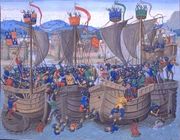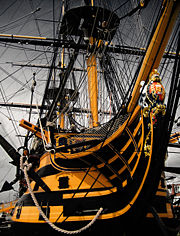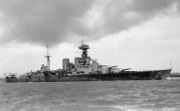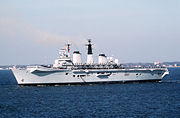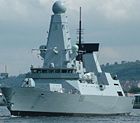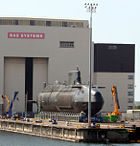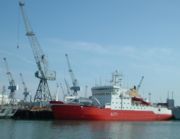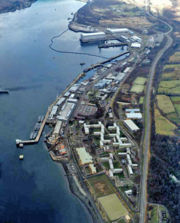Royal Navy
2008/9 Schools Wikipedia Selection. Related subjects: Military History and War
|
Naval Service
of the British Armed Forces
|
|---|
| Components |
|
Royal Navy Surface FleetFleet Air Arm Submarine Service Royal Navy Regulating Branch Royal Naval Reserve Nursing Service (QARNNS) |
| Royal Marines Reserve |
| History and future |
| History of the Royal Navy History of the Royal Marines Future of the Royal Navy |
| Ships |
| Current fleet Current deployments Historic ships |
| Personnel |
| The Admiralty Senior officers Uniforms Officer rank insignia Ratings rank insignia |
| Related civilian agencies of the Ministry of Defence |
| Royal Fleet Auxiliary Royal Maritime Auxiliary Service |
The Royal Navy of the United Kingdom is the oldest of the British armed services (and is therefore known as the Senior Service). From the early 18th century to the middle of the 20th century, it was the largest and most powerful navy in the world, playing a key part in establishing the British Empire as the dominant power of the 19th and early 20th centuries. In World War II, the Royal Navy operated almost 900 ships. During the Cold War, it was transformed into a primarily anti-submarine force, hunting for Soviet submarines, mostly active in the GIUK gap. With the collapse of the Soviet Union, its role for the 21st century has returned to focus on global expeditionary operations.
The Royal Navy is the second-largest navy of the NATO allies, in terms of the combined displacement of its fleet, after the U.S. Navy. There are currently 91 commissioned ships in the Royal Navy, including aircraft carriers, nuclear submarines, mine counter-measures and patrol vessels. There are also the support of 17 vessels of the Royal Fleet Auxiliary. The Royal Navy's ability to project power globally is considered second only to the United States Navy. The Royal Navy also has the second largest carrier fleet in the world, with 2 carriers of the Invincible class in service (HMS Ark Royal and HMS Illustrious), another of the same class in reserve ( HMS Invincible) and 2 of the Queen Elizabeth class planned to replace the current fleet of aircraft-carriers. (However, to place this in perspective, the combined full load displacement of the Royal Navy's two active carriers is only 42,000 tons, while the single Russian carrier Admiral Kuznetsov displaces more than 65,000 tons full load and the combined displacement of the US carrier fleet is more than one million tons).
The Royal Navy is a constituent component of the Naval Service, which also comprises the Royal Marines, Royal Fleet Auxiliary, Royal Naval Reserve and Royal Marines Reserve. The Royal Navy numbers 37,500 people of whom approximately 6,000 are in the Royal Marines.
History
(all headings after 1603 and the Union of the Crowns apply to the United Kingdom)
900–1500
England's first navy was established in the 9th century by Alfred the Great but, despite inflicting a significant defeat on the Vikings in the Wantsum Channel at Plucks Gutter near to Stourmouth, Kent, it fell into disuse. It was revived by King Athelstan and at the time of his victory at the Battle of Brunanburh in 937, the English navy had a strength of approximately 400 ships. When the Norman invasion was imminent, King Harold had trusted to his navy to prevent William the Conqueror's invasion fleet from crossing the Channel. However, not long before the invasion the fleet was damaged in a storm and driven into harbour, and the Normans were able to cross unopposed and defeat Harold at the Battle of Hastings. The Norman kings created a naval force in 1155, or adapted a force which already existed, with ships provided by the Cinque Ports alliance. The Normans are believed to have established the post of Lord Warden of the Cinque Ports.
The English Navy began to develop during the 12th and 13th centuries and King John had a fleet of 500 sails. During the Hundred Years' War, the French fleet was initially stronger than the English fleet, but was almost completely destroyed at the Battle of Sluys in 1340. In the mid-fourteenth century Edward III's navy had some 712 ships. There then followed a period of decline: the navy suffered disastrous defeats off La Rochelle in 1372 and 1419 to Franco - Castilian fleets, and English ports were ravaged by fleets commanded by Jean de Vienne and Fernando Sánchez de Tovar.
1500–1707
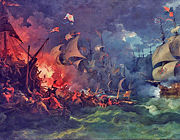
The first reformation and major expansion of the Navy Royal, as it was then known, occurred in the 16th century during the reign of Henry VIII, whose ships Henri Grâce a Dieu ("Great Harry") and Mary Rose engaged the French navy in the battle of the Solent in 1545. By the time of Henry's death in 1547 his fleet had grown to 58 vessels. In 1588 the Spanish Empire, at the time Europe's superpower and the leading naval power of the 16th century, and the Spanish Armada set sail to enforce Spain's dominance over the English Channel and transport troops from the Spanish Netherlands to England. The Spanish plan failed due to maladministration, logistical errors, English harrying, blocking actions by the Dutch, and bad weather. However, England led a similar large-scale expedition against Spain a year later in what is known as the Drake-Norris Expedition of 1589, which resulted in defeat for the Royal Navy.
A permanent Naval Service did not exist until the mid-17th century, when the 'General-at-Sea' (equivalent to Admiral) Robert Blake took the Fleet Royal under Parliamentary control following the defeat of Charles I. After defeats in the second and third Anglo-Dutch Wars the Royal Navy gradually developed into the strongest navy in the world. From 1692 the Dutch navy was placed under the command of the Royal Navy's admirals (though not incorporated into it) by order of William III following the Glorious Revolution.
Under the Acts of Union in 1707 the Royal Scots Navy merged with the English Navy and the modern Royal Navy came into being. The Royal Navy had become the British navy.
1707–1914
The early 18th century saw the Royal Navy with more ships than other navies. Although it suffered severe financial problems throughout the earlier part of this period, modern methods of financing government and in particular, the Navy were developed. This financing enabled the navy to become the powerful force of the later 18th century without bankrupting the country. Naval operations in the War of the Spanish Succession were at first focused on the acquisition of a Mediterranean base, culminating in an alliance with Portugal and the capture of Gibraltar (1704) and Port Mahon (1708). The middle part of the century was occupied with the War of the Austrian Succession and the lesser known War of Jenkins' Ear against Spain. In the latter war, the British deployed a very large amphibious force under Admiral Edward Vernon in the Battle of Cartagena, aiming to capture this major Spanish colonial port in modern day Colombia. Following an able defense assisted by strong fortifications, and the ravages of disease, the British failed in their attempts suffering heavy casualties. The Navy also saw action in the Seven Years' War which was later described by Winston Churchill as the first world war. The latter part of the century saw action in the American Revolutionary War where the Navy was defeating the fledgling Continental Navy until French intervention in 1778. The most important operation of the war came in 1781 when during the Battle of the Chesapeake the British failed to lift the French blockade of Lord Cornwallis, resulting in a British surrender in the Battle of Yorktown. Although combat was over in North America, it continued in the Caribbean ( Battle of the Saintes) and India, where the British experienced both successes and failures.
The Napoleonic Wars saw the Royal Navy reach a peak of efficiency, dominating the navies of all Britain's adversaries. Initially Britain did not involve itself in the French Revolution, but in 1793 France declared war. The next 12 years saw battles such as the Cape St Vincent and the Nile and short lived truces such as the Peace of Amiens. In the early stages of the wars, the navy had several mutinies caused mostly by the sailors' poor conditions of service. The two major mutinies at the Spithead and the Nore in 1797, were potentially very dangerous for Britain, because at the time the country was at risk of a French invasion.
The height of the Navy's achievements though came on 21 October 1805 at the Battle of Trafalgar where a numerically smaller but more experienced British fleet under the command of Admiral Lord Nelson decisively defeated a combined French and Spanish fleet. This eventually led to almost uncontested power over the world's oceans from 1805 to 1914, when it came to be said that " Britannia ruled the waves".
In the years following the battle of Trafalgar there was increasing tension at sea between Britain and the United States. American traders took advantage of their country's neutrality to trade with both the French-controlled parts of Europe and Britain. Both France and Britain tried to prevent each other's trade, but only the Royal Navy was in a position to enforce a blockade. In 1812, the United States declared war on the United Kingdom and invaded Canada. At sea, the American War of 1812 was characterised by single-ship actions between small ships, and disruption of merchant shipping. Between 1793 and 1815 the Royal Navy lost 344 vessels due to non-combat causes: 75 by foundering, 254 shipwrecked and 15 from accidental burnings or explosions. In the same period it lost 103,660 seamen: 84,440 by disease and accidents, 12,680 by shipwreck or foundering, and 6,540 by enemy action. During the 19th century the Royal Navy enforced a ban on the slave trade, acted to suppress piracy, and continued to map the world. To this day, Admiralty charts are maintained by the Royal Navy. Royal Navy vessels on surveying missions carried out extensive scientific work. Charles Darwin travelled around the world on HMS Beagle, making scientific observations which led him to the theory of evolution.
The end of the 19th century saw structural changes brought about by the First Sea Lord (Chief of Staff) Jackie Fisher who retired, scrapped, or placed into reserve many of the older vessels, making funds and manpower available for newer ships. He also oversaw the development of HMS Dreadnought, the first all-big-gun ship and one of the most influential ships in naval history. This ship rendered all other battleships then existing obsolete, and started an arms race in Europe. Admiral Percy Scott introduced several new programs such as gunnery training programs and central fire control which greatly improved the effectiveness in battle of the Navy's ships. The First Lord of the Admiralty is a civilian and a member of the Government.
1914–1945
During the two World Wars, the Royal Navy played a vital role in keeping the United Kingdom supplied with food, arms and raw materials and in defeating the German campaigns of unrestricted submarine warfare in the first and second battles of the Atlantic. During the First World War, the majority of the Royal Navy's strength was deployed at home in the Grand Fleet. The primary aim was to draw the Hochseeflotte (the German "High Seas Fleet") into an engagement. No decisive victory ever came though. The Royal Navy and the Kaiserliche Marine fought many engagements including the Battle of Heligoland Bight, and the Battle of Jutland. Although it suffered heavier losses than the Hochseeflotte it did succeed in preventing the German Fleet from putting to sea in the latter stages of the War.
In the inter-war period the Royal Navy was stripped of much of its power. The Washington Naval Treaty of 1922, together with the deplorable financial conditions during the immediate post-war period and the Great Depression, forced the Admiralty to scrap some capital ships and to cancel plans for new construction. The London Naval Treaty of 1930 deferred new capital ship construction until 1937 and reiterated construction limits on cruisers, destroyers and submarines. As international tensions increased in the mid-1930s the Second London Naval Treaty of 1935 failed to halt the development of a naval arms race and by 1938 treaty limits were effectively ignored. The re-armament of the Royal Navy was well under way by this point; the Royal Navy had begun construction of the King George V class and several aircraft carriers including Ark Royal. In addition to new construction, several existing old battleships, battlecruisers and heavy cruisers were reconstructed, and anti-aircraft weaponry reinforced. However around this time, the Imperial Japanese Navy and the United States Navy began to surpass the Royal Navy in power.
During the early phases of World War II, the Royal Navy provided critical cover during British evacuations from Dunkirk. At the Battle of Taranto Admiral Cunningham commanded a fleet that launched the first all-aircraft naval attack in history. Later Cunningham was determined that as many Commonwealth soldiers as possible should be evacuated after their defeat on Crete. When army generals feared he would lose too many ships, he famously said, "It takes three years to build a ship; it takes three centuries to build a tradition".
The Royal Navy suffered huge losses in the early stages of the war including HMS Hood, HMS Repulse and HMS Prince of Wales despite successes against enemy surface ships, in particular at Norway. As well as providing cover in operations it was also vital in guarding the sea lanes that enabled British forces to fight in remote parts of the world such as North Africa, the Mediterranean and the Far East. Naval supremacy in the Atlantic was vital to the amphibious operations carried out, such as the invasions of Northwest Africa, Sicily, Italy, and Normandy. During the war however, it became clear that aircraft carriers were the new capital ship of naval warfare, and that Britain's former naval superiority in terms of battleships had become irrelevant. Though Britain was an early innovator in aircraft carrier design and in many naval technologies, it did not have the resources to pursue this in the post-war period.
Postwar period and 21st century
After World War II, the decline of the British Empire and the economic hardships in Britain at the time forced the reduction in the size and capability of the Royal Navy. The increasingly powerful U.S. Navy took on the former role of the Royal Navy as global naval power. However, the threat of the Soviet Union and British commitments throughout the world created a new role for the Navy.
The 1960s saw the peak of the Royal Navy's capabilities in the post-war era. The two Audacious class fleet carriers HMS Ark Royal, HMS Eagle, the rebuilt HMS Victorious and the four Centaur class light carriers gave the Royal Navy the most powerful carrier fleet outside the United States. The navy also had a large fleet of frigates and destroyers. New, more modern units like the County-class destroyers and Leander-class frigates also began to enter service in the 1960s.
The 1960s also saw the launch of HMS Dreadnought, the Royal Navy's first SSN. The navy also received its first nuclear weapons with the introduction of the first of the Resolution class submarines and was later to become responsible for the maintenance of the UK's entire nuclear deterrent.
The Navy began plans for a replacement of its fleet of aircraft carriers in the mid-1960s. A plan was drawn up for 3 large aircraft carriers each displacing about 60,000 tons; the plan was designated CVA-01. These carriers would be able to operate the latest aircraft that were coming into service, and would keep the Royal Navy’s place as a major naval power. However, the new Labour government that came into power in the mid-1960s was determined to cut defence expenditure as a means to reduce public spending, and in the 1966 Defence White Paper the project was cancelled.
After this the navy began to fall in size and by 1979 the last fleet carrier, HMS Ark Royal, was scrapped. The navy was forced to make do with three much smaller Invincible-class aircraft carriers, and the fleet was now centred around anti-submarine warfare in the north Atlantic as opposed to its former position with world wide strike capability.
The most important operation conducted predominantly by the Royal Navy after the Second World War was the defeat in 1982 of Argentina in the Falkland Islands War. Despite losing four naval ships and other civilian and RFA ships the Royal Navy proved it was still able to fight a battle 8,345 miles (12,800 km) from Great Britain. HMS Conqueror is the only nuclear-powered submarine to have engaged an enemy ship with torpedoes, sinking the Argentine cruiser ARA General Belgrano. The war also underlined the importance of aircraft carriers and submarines and exposed the service's late 20th century dependence on chartered merchant vessels. The Royal Navy also took part in the Gulf War, the Kosovo conflict, the Afghanistan Campaign, and the 2003 Iraq War, the last of which saw RN warships bombard positions in support of the Al Faw Peninsula landings by Royal Marines. In August 2005 the Royal Navy rescued seven Russians stranded in a submarine off the Kamchatka peninsula. Using its Scorpio 45, a remote-controlled mini-sub, the submarine was freed from the fishing nets and cables that had held the Russian submarine for three days.
The Royal Navy today
Fleet composition
In numeric terms the Royal Navy has significantly reduced in size since the 1960s, reflecting the reducing requirement of the state. This raw figure does not take into account the increase in technological capability of the Navy's ships, but it does show the general reduction of capacity. The following table is a breakdown of the fleet numbers since 1960. The separate types of ship and how their numbers have changed are shown.
| Year | Submarines | Carriers | Assault Ships | Surface Combatants | Mine Counter Measure Vessels | Patrol Ships and Craft | Total | ||||||||
|---|---|---|---|---|---|---|---|---|---|---|---|---|---|---|---|
| Total | SSBN | SSN | SS & SSK | Total | CV | CV(L) | Total | Cruisers | Destroyers | Frigates | |||||
| 1960 | 48 | 0 | 0 | 48 | 9 | 6 | 3 | 0 | 145 | 6 | 55 | 84 | 202 | ||
| 1965 | 47 | 0 | 1 | 46 | 6 | 4 | 2 | 0 | 117 | 5 | 36 | 76 | 170 | ||
| 1970 | 42 | 4 | 3 | 35 | 5 | 3 | 2 | 2 | 97 | 4 | 19 | 74 | 146 | ||
| 1975 | 32 | 4 | 8 | 20 | 3 | 1 | 2 | 2 | 72 | 2 | 10 | 60 | 43 | 14 | 166 |
| 1980 | 32 | 4 | 11 | 17 | 3 | 0 | 3 | 2 | 67 | 1 | 13 | 53 | 36 | 22 | 162 |
| 1985 | 33 | 4 | 14 | 15 | 4 | 0 | 4 | 2 | 56 | 0 | 15 | 41 | 45 | 32 | 172 |
| 1990 | 31 | 4 | 17 | 10 | 3 | 0 | 3 | 2 | 49 | 0 | 14 | 35 | 41 | 34 | 160 |
| 1995 | 16 | 4 | 12 | 0 | 3 | 0 | 3 | 2 | 35 | 0 | 12 | 23 | 18 | 32 | 106 |
| 2000 | 16 | 4 | 12 | 0 | 3 | 0 | 3 | 3 | 32 | 0 | 11 | 21 | 21 | 23 | 98 |
| 2005 | 15 | 4 | 11 | 0 | 3 | 0 | 3 | 2 | 28 | 0 | 9 | 19 | 16 | 26 | 90 |
| 2006 | 14 | 4 | 10 | 0 | 3 | 0 | 3 | 3 | 25 | 0 | 8 | 17 | 16 | 22 | 83 |
| 2007 | 13 | 4 | 9 | 0 | 3 | 0 | 3 | 3 | 25 | 0 | 8 | 17 | 16 | 22 | 82 |
Before the Falklands War in 1982, the then Defence Secretary John Nott had advocated, and initiated, a series of cutbacks to the Navy. The Falklands War though, proved a need for the Royal Navy to regain an expeditionary and littoral capability which, with its resources and structure at the time, would prove difficult. With the end of the Cold War at the beginning of the 1990s, the Royal Navy was a force focused on blue water anti-submarine warfare. Its purpose was to search for and destroy Soviet submarines in the North Atlantic, and to operate the nuclear deterrent submarine force.
UK foreign policy after the end of the Cold War has given rise to a number of operations which have required an aircraft carrier to be deployed globally such as the Adriatic, Peace Support Operations in Bosnia and Herzegovina and Kosovo, Sierra Leone, the Persian Gulf. Destroyers and frigates have been deployed against piracy in the Malacca Straits and Horn of Africa. Consequently in the 1990s the navy began a series of projects to modernise the fleet and convert it from a North Atlantic-based anti-submarine force to an expeditionary force. This has involved the replacement of much of the Fleet and has seen a number of large procurement projects.
Large fleet units – amphibious and carriers
The two recently ordered Queen Elizabeth-class aircraft carriers are to be a new generation of aircraft carrier to replace the three Invincible class ships. The two vessels are expected to cost £3.9 billion, will displace 65,000 tons and are expected to enter service in 2014 and 2016 respectively. They will be STOVL carriers, operating the STOVL variant of the F-35 Lightning II, which has been ordered by both the Fleet Air Arm and the Royal Air Force to replace the Harrier.
The introduction of the 4 vessels of the Bay class of landing ship dock into the Royal Fleet Auxiliary in 2006 and 2007, together with the Albion class means that the Royal Navy has a significantly enhanced amphibious capability. In November 2006 the First Sea Lord, Admiral Sir Jonathon Band, said, "These ships represent a major uplift in the Royal Navy's war fighting capability."
Escort units
The escort fleet, in the form of frigates and destroyers, is the traditional workhorse of the Navy. The escort fleet is also being updated. The ageing Type 42 destroyer is to be replaced with the Type 45 destroyer.
Six Type 45 destroyers are on order or under construction. Under the terms of the original contract, the Navy was to order 12 vessels but, as of June 2008, only the six will be constructed. The main role of the Type 45 destroyer is anti-air warfare. In order to fulfil this role, it will be equipped with the PAAMS integrated anti-aircraft system. This will fire Aster 15 and Aster 30 missiles. The Type 45 will operate the highly sophisticated Sampson radar system that will be fully integrated into the PAAMS system.
The last frigate to enter service was the Type 23 frigate, HMS St Albans. On July 21, 2004, in the Delivering Security in a Changing World review of defence spending, Defence Secretary Geoff Hoon announced that 3 frigates would be paid off as part of a continuous cost-cutting strategy. Several designs have been created for a new generation frigate such as the Future Surface Combatant, but these concepts have not yet obtained Main Gate approval.
Submarines
The submarine force is being replaced and replenished, with 4 new Astute-class submarines ordered. These are much larger than their predecessors, the Trafalgar class and are expected to displace 7,800 tons submerged. In December 2006, plans were unveiled for a new class of three submarines to replace the Vanguard-class submarine, which is due to be replaced by 2024. This new class will mean that the United Kingdom will maintain a nuclear ballistic missile submarine fleet and the ability to launch nuclear weapons.
Other vessels
At the beginning of the 1990s the Royal Navy had two classes of Offshore Patrol vessel, the Island class, and the larger Castle class. However, in 1997 a decision was taken to replace them. An order for three much larger offshore patrol vessels, the River class was placed in 2001. Unusually, the three River class ships are owned by Vosper Thorneycroft, and leased to the Royal Navy until 2013. A modified River class vessel, HMS Clyde, was commissioned in July 2007 and will become the Falkland Islands guardship. The Royal Navy also has the Sandown-class minehunter and the Hunt class mine countermeasure vessel. The Hunt class of 8 vessels are mine countermeasure vessels that combine the separate role of the traditional minesweeper and that of the active minehunter in one hull. When needed they take on the role of offshore patrol vessels. The Royal Navy has a mandate to provide support to the British Antarctic Survey (BAS), which comes in the form of the dedicated Antarctic Patrol Ship HMS Endurance. The four Hecla class vessels were replaced by the survey vessel HMS Scott which surveys the ocean floor. HMS Roebuck meanwhile, surveys the UK continental shelf or other shallow waters in support of the larger vessels. The other survey vessels of the Royal Navy are the two multi-role ships of the Echo class which came into service in 2002 and 2003.
Current role
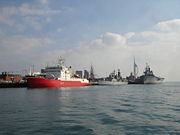
The current role of the Royal Navy (RN) is to protect British interests at home and abroad, executing the foreign and defence policies of Her Majesty's Government through the exercise of military effect, diplomatic activities and other activities in support of these objectives. The RN is also a key element of the UK contribution to NATO, with a number of assets allocated to NATO tasks at any time. These objectives are delivered via a number of core capabilities:
- Maintenance of the UK Nuclear Deterrent through a policy of Continuous at Sea Deterrence.
- Provision of two medium scale maritime task groups with organic air assets.
- Delivery of the UK Commando force.
- Contribution of assets to Joint Force Harrier.
- Contribution of assets to the Joint Helicopter Command.
- Maintenance of standing patrol commitments.
- Provision of Mine Counter Measures capability to UK and allied commitments.
- Provision of Hydrographic and meteorological services deployable worldwide.
- Protection of the UK and EU's Exclusive Economic Zone.
Current deployments
The Royal Navy is currently deployed in many areas of the world, including a number of standing Royal Navy deployments. These include several home tasks as well as oversea deployments. The Royal Navy is deployed in the Mediterranean as part of standing NATO deployments including mine countermeasures and NATO Maritime Group 2. In both the North and South Atlantic Royal Naval vessels are patrolling. There is always a Falkland Islands Patrol Vessel on deployment, currently the new vessel HMS Clyde. The Royal Navy is also deployed in the Middle East to provide "maritime security and surveillance in the Northern Persian Gulf".
Command, control and organisation
The head of the Royal Navy is the Lord High Admiral, a position which has been held by the Sovereign since 1964 (the Sovereign being the overall head of the Armed Forces).
The professional head of the Naval Service is the First Sea Lord, an Admiral and member of the Defence Council. The Defence council delegates management of the Naval Service to the Admiralty Board, chaired by the Secretary of State for Defence, which directs the Navy Board, a sub-committee of the Admiralty Board comprising only Naval Officers and Ministry of Defence (MOD) Civil Servants. These are all based in MOD Main Building in London, where the First Sea Lord, also known as the Chief of the Naval Staff, is supported by the Naval Staff Department.
Senior leadership
As of July 2007, the following persons were in office:
- Lord High Admiral: Queen Elizabeth II.
- Naval members of the Admiralty Board:
- First Sea Lord: Admiral Sir Jonathon Band, based in MOD Main Building
- Commander-in-Chief Fleet: Admiral Sir Mark Stanhope
- Second Sea Lord: Vice Admiral Sir Adrian Johns KCB, CBE, based in HMS Excellent, Principal Personnel Officer for the Naval Service, also Rear Admiral Fleet Air Arm.
- Assistant Chief of the Naval Staff: Rear Admiral A M Massey CBE, based in MOD Main Building
- Controller of the Navy: Rear Admiral Andrew Mathews, based in Defence Equipment & Support, MOD Abbey Wood
- Naval Member for Logistics: Rear Admiral Amjad Hussain, based in Defence Equipment & Support, MOD Ensleigh
Fleet command
Full command of all deployable fleet units (including the Royal Marines and the Fleet Auxiliary) is the responsibility of Commander-in-Chief Fleet (CINCFLEET), with a Command Headquarters at HMS Excellent in Portsmouth and an Operational Headquarters at Northwood, Middlesex. The latter is co-located with the Permanent Joint Headquarters of the United Kingdom's armed forces, and a NATO Regional Command, Allied Maritime Component Command Northwood (AMCCN). CINCFLEET is also Commander AMCCN. The purpose of CINCFLEET is to provide ships and submarines and commando forces at readiness to conduct military and diplomatic tasks as required by the UK government, including the recruitment and training of personnel.
- Commander-in-Chief Fleet Headquarters:
- Deputy CINC and Chief of Staff: Vice Admiral Paul Boissier, (based in HMS Excellent, commands the Headquarters).
- Commander Operations: Rear Admiral D J Cooke (based at Northwood, also Rear Admiral Submarines and Commander Submarine Allied Forces North (NATO)).
- Commander UK Maritime Forces: Rear Admiral Neil Morisetti, (deployable Force Commander responsible for Maritime Battle Staffs; UK Task Group, UK Amphibious Task Group, UK Maritime Component Command).
- Commander UK Amphibious Force: Major General G S Robison, also the Commandant General Royal Marines
Locations
The Royal Navy currently operates three bases in the United Kingdom where commissioned ships are based; Portsmouth, Clyde and Devonport. Each base hosts a Flotilla Command under a Commodore, or in the case of Faslane a Captain, responsible for the provision of Operational Capability using the ships and submarines within the flotilla. 3 Commando Brigade Royal Marines is similarly commanded by a Brigadier and based in Plymouth.
Historically the Royal Navy maintained Royal Navy Dockyards around the world. Dockyards of the Royal Navy are harbours where ships are overhauled and refitted. Only four are operating today; at Devonport, Faslane, Rosyth and at Portsmouth. A Naval Base Review was undertaken in 2006 and early 2007, the outcome being announced by Secretary of State, Des Browne the Defence secretary confirming that all would remain however some reductions in manpower were anticipated.
The academy where initial training for future Royal Navy officers takes place is Britannia Royal Naval College, located on a hill overlooking Dartmouth, Devon, England.
Significant numbers of naval personnel are employed within the Ministry of Defence, Defence Equipment and Support and on exchange with the Army and Royal Air Force. Small numbers are also on exchange within other government departments.
Special forces
The Royal Navy, through the Royal Marines, provides the Special Boat Service (SBS), one of the three Special Forces units within the United Kingdom Special Forces group. The SBS is a maritime Special Forces capability is an independent force element of the Royal Marines. Based at RM Poole in Poole, Dorset it is made up of 4 operational squadrons and an element of the Royal Marines Reserve which provides individual trained ranks to the regular force.
Roles include maritime activities such as covert shore reconnaissance, small boat operations, amphibious raiding and Maritime Counter-Terrorism however the force also conducts traditional land-centric activities.
The SBS provides the special forces element of 3 Commando Brigade when deployed.
Titles and naming
Of the Royal Navy
The British Royal Navy is commonly referred to as the "Royal Navy" both in the United Kingdom and other countries. Navies of Commonwealth of Nations countries where the British monarch is also head of state also include their national name e.g. Royal Australian Navy. Some navies of other monarchies, such as the Koninklijke Marine (Royal Netherlands Navy) and Kungliga Flottan (Royal Swedish Navy), are also called "Royal Navy" in their own language.
Of ships
Royal Navy ships in commission are prefixed with Her Majesty's Ship ( His Majesty's Ship), abbreviated to HMS, e.g., HMS Ark Royal. Submarines are styled HM Submarine, similarly HMS. Names are allocated to ships and submarines by a naming committee within the MOD and given by class, with the names of ships within a class often being thematic (e.g.. the Type 23 class are named after British Dukes) or traditional (e.g., the Invincible class all carry the names of famous historic ships). Names are frequently re-used offering a new ship the rich heritage, battle honours and traditions of her predecessors.
As well as a name each ship, and submarine, of the Royal Navy and the Royal Fleet Auxiliary is given a pennant number which in part denotes its role.
Custom and tradition
The Royal Navy has several formal customs and traditions including the use of ensigns and ships badges. Royal Navy ships have several ensigns used when under way and when in port. Commissioned ships and submarines wear the White Ensign at the stern whilst alongside during daylight hours and at the main-mast whilst under way. When alongside, the Union Jack (as distinct from the Union Flag, often referred to as the Union Jack) is flown from the jackstaff at the bow, and can only be flown under way either to signal a court-martial is in progress or to indicate the presence of an Admiral of the Fleet on-board (including the Lord High Admiral, the Monarch).
The Fleet Review is an irregular tradition of assembling the fleet before the monarch. The first review is purported to have been held in 1400 and the most recent review was held on 28 June 2005. This was to mark the bi-centenary of the Battle of Trafalgar; 167 ships from many different nations attended with the Royal Navy supplying 67.
Another popular tradition of the British Navy is that they play several cricket matches with local teams. They even play matches against the Australian Navy in what they call 'The Ashes.'
There are several less formal traditions including service nicknames and Naval slang.The nicknames include "The Andrew" (of uncertain origin, possibly after a zealous press ganger) and "The Senior Service". The RN has evolved a rich volume of slang, known as "Jack-speak". Nowadays the British sailor is usually "Jack" (or "Jenny") rather than the more historical " Jack Tar". Royal Marines are fondly known as "Bootnecks" or often just as "Royals". The current compendium of Naval slang was brought together by Commander A. Covey-Crump and his name has in itself become the subject of Naval slang; Covey Crump. A game traditionally played by the Navy is the four player board game called Uckers. This is similar to Ludo and it is regarded as extremely difficult to learn.
In popular culture
The Royal Navy's Napoleonic campaigns are a popular subject of historical novels. Some of the best-known include Patrick O'Brian's Aubrey-Maturin series, C.S. Forester's Horatio Hornblower chronicles, Dudley Pope's Lord Ramage novels and Douglas Reeman's Richard Bolitho novels. Alexander Kent is a pen name of Douglas Reeman who, under his birth name, has written many novels featuring the Royal Navy in the two World Wars. Other well-known novels include Alistair MacLean's HMS Ulysses, Nicholas Monsarrat's The Cruel Sea, and C.S. Forester's The Ship, all set during World War II.
The Navy can also be seen in several films. The fictional spy James Bond is 'officially' a commander in the Royal Navy. The Royal Navy is featured in The Spy Who Loved Me, where a missile submarine is stolen, and in Tomorrow Never Dies when a media baron sinks a Royal Navy warship in an attempt to trigger a war between the UK and People's Republic of China. Master and Commander: The Far Side of the World was based on Patrick O'Brian's Aubrey-Maturin series. The Pirates of the Caribbean series of films also includes the Navy as the force pursuing the eponymous pirates. Noel Coward directed and starred in his own film In Which We Serve, which tells the story of the crew of the fictional HMS Torrin during World War II. It was intended as a propaganda film and was released in 1942. Coward starred as the ship's captain, with supporting roles from John Mills and Richard Attenborough.
CS Forester's Hornblower novels have been adapted for television, as have Bernard Cornwell's Sharpe series, which, although primarily involving the Peninsular War of the time, includes several novels involving Richard Sharpe at sea with the Navy. The Royal Navy was the subject of an acclaimed 1970s BBC television drama series, Warship, and of a five-part documentary, Shipmates, that followed the workings of the Royal Navy day to day.
The popular BBC radio comedy series The Navy Lark featured a fictitious warship ("HMS Troutbridge") and ran from 1959 to 1977.

